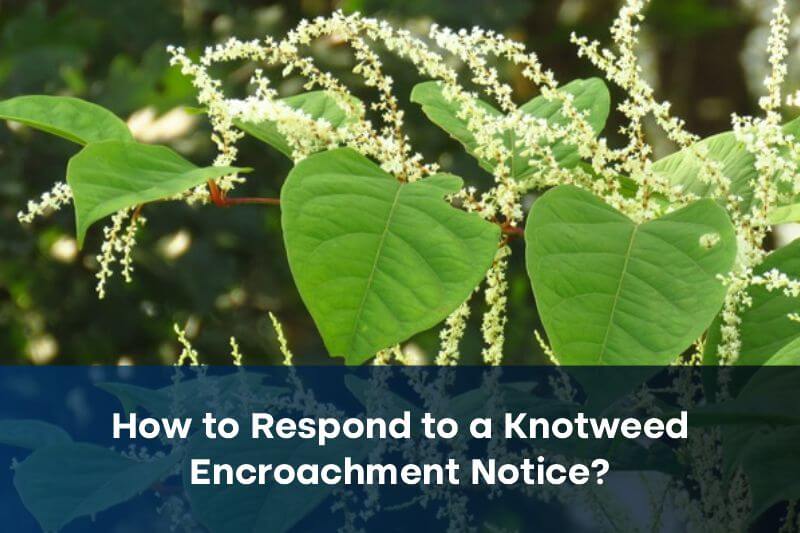Japanese knotweed is a very invasive plant that can seriously impact the property and land value. A knotweed encroachment notice means this destructive weed is encroaching on your property from a neighbour’s or the other way. Encroachment notices are alarming because of the potential for litigation and even more significant remediation costs.
This document provides a full, step-by-step guide to respond to a knotweed encroachment notice, and when and why you should talk to a Japanese knotweed lawyer to advocate for your rights and interests.
Steps to Respond to a Knotweed Encroachment Notice
A response to a knotweed notice can be planned effectively, but first, you must understand how the process works and what your next steps are. The following steps set out the main practical and legal steps you need to undertake to deal with it properly:
Step 1: Identify Knotweed & the Encroachment Issue
You should identify that the plant is knotweed before taking any further steps. Mistakes regarding weed identification could lead to unnecessary costs and disputes. You should be undertaking a proper professional knotweed survey.
The knotweed surveyor will identify the species, map the spread, and prepare a report. This report will be needed to evidence the encroachment and may also be crucial if you later involve a Japanese knotweed solicitor.
Step 2: Confirm the Responsible Party for your Knotweed
The party mainly responsible for knotweed is typically the landowner who has spread the knotweed. But these can be tricky, and determining who is liable requires experts who are versed in the science, as knotweed roots may be spreading underground with no visible indication on the surface.
After determining the responsible party, treatment should commence as soon as possible to avoid harm and limit the spread to other properties. Common solutions are typically herbicides, excavation, or barrier systems.
Step 3: Speak to Your Neighbour
Working together with your neighbour on a joint action plan may reduce harm, salvage your relationship, and lessen the attached liability. Open-minded and collaborative approaches to work together are typically the shortest and cheapest route to rectifying a problem.
Alternative professional assistance from a Japanese knotweed solicitor might be possible, where discussions have not worked; an independent mediator, a third party, could assist.
Step 4: Consult A Japanese Knotweed Solicitor For Specialist Legal Advice
Japanese knotweed issues often encompass intricate matters about property rights, nuisance law, or environmental law. We advise that you consult a Japanese knotweed solicitor at your earliest convenience to establish your rights and obligations for your property.
A Japanese knotweed lawyer or solicitor who has experience in the knotweed area should be able to provide you with the best protection for your interests.
Step 5: Implement a Professional Knotweed Treatment Plan
Once the responsible party has been identified, treatment must commence in a timely and time-dependent manner. Normal control measures are herbicide treatments over many years, removal of contaminated soil, and installation of root barriers.
Working with contractors who are typically experienced and comply with industry best practice is recommended. Expert documentation from the professionals would be helpful if legal action is needed. A Japanese knotweed solicitor can help you ensure this documentation meets legal standards.
Step 6: Responding to the Notice of Encroachment
You must respond to the knotweed encroachment notice in writing by the date specified in the notice. It is necessary to acknowledge receipt and explicitly describe any steps you propose to the knotweed situation. If you believe you have grounds to dispute the claim, consider enclosing all supporting evidence with your response.
As a matter of course, it is probably good to have a written record of any communication. This will ensure an audit trail to look back on if mediation is necessary or the matter is escalated to a legal dispute. A Japanese knotweed solicitor can assist with a review of your response to ensure it is sufficiently comprehensive and legally robust.
Step 7: Take Account of Your Legal Responsibilities
You can commence legal proceedings if your neighbour does not deal with the knotweed invading your property once you have made a formal request. You can issue a claim under private nuisance or an injunction to compel your neighbour to remove the knotweed.
Your local authority could also issue Community Protection Notices requiring landowners to manage the knotweed. If your neighbour fails to comply, then they may be fined or referred for enforcement.
Conclusion
Dealing with a knotweed encroachment notice involves assessment, dialogue, remediation, and possibly legal advice to register to protect your property or commons. If you have received a Japanese knotweed encroachment notice or are concerned about a potential encroachment, contact Jiva Solicitors today. Jiva Solicitors will provide you with specific advice and effective representation for your rights. You must contact the Japanese knotweed solicitors on time to obtain the best outcome.
Take action now to protect your home, your rights, and your property value. Contact Jiva Solicitors for a free consultation with leading Japanese knotweed solicitors.



